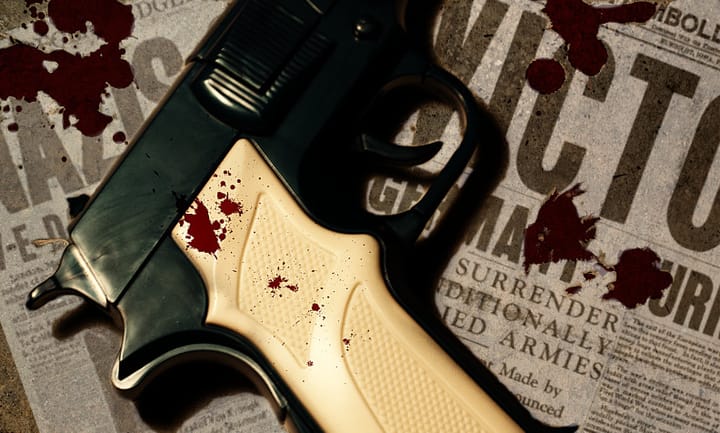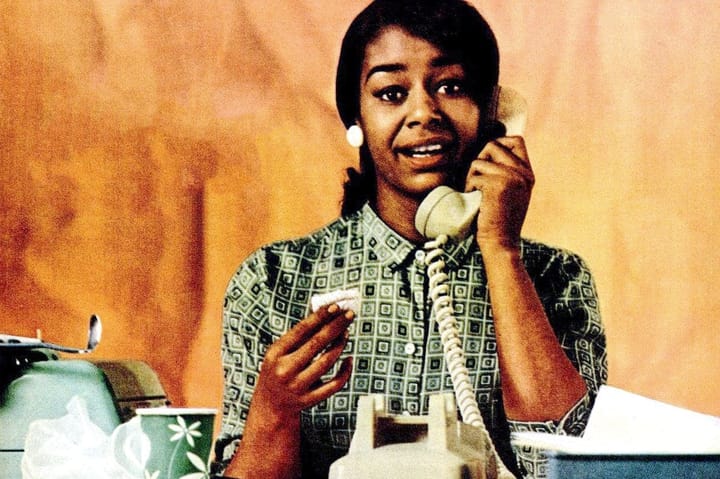Popcorn and Purple Stuff: A journey through 1990s cinema, in 25 films. (Part III)
The third installment of 1990s cinema takes us to a convenience store in New Jersey, an apocalyptic desert in Australia, and the mean streets of L.A.

This is the third entry in my series on 1990s cinema and how the movies of that decade can shed a light on America’s history in that period. I’ve chosen 25 films that I think embody the values, style and characteristics unique to 1990s cinema. Part I, featuring films from 1990 and 1991, is here. Part II, relating to 1992 and 1993, is here. This is not a “best-of” list, or a “my favorites” list. It’s thematic and analytical. This article deals with films from 1994 and 1995.
Clerks (1994, Kevin Smith, Director)
Kevin Smith’s grainy, low-budget and blisteringly profane comedy Clerks, an unexpected hit in 1994, is about a lot more than just two schlubs (Brian O’Halloran and Jeff Anderson) who work shitty convenience store jobs and trade pop culture references. It’s about finding yourself at prime working age in a time when jobs like these were about all that was left for many Americans. The traditional “American dream,” if it ever existed in the first place, began to evaporate in the 1970s as the U.S. ceded its manufacturing and economic dominance to Asia and became primarily a service economy. But it took about 20 years for everyone to stop pretending that the world had changed. Generation X, much of which came into adulthood about the time Clerks came out, noticed right away. Instead of lamenting it, Kevin Smith, the first true breakout Gen-X director, chose to laugh at it.
Clerks could not have found resonance at any time than exactly when it was made. A few years earlier and it would have been just an indie oddity like Richard Linklater’s Slacker (1991); a few years later it would have had nothing left of any relevance to say. By the late 1990s the decline of the American dream was normalized and internalized. It was no longer news. The fact that Kevin Smith tried essentially to keep remaking this picture for the rest of his career, with increasingly diminishing results, shows how fragile and temporary Clerks’s cultural moment was. Still, it remains a funny and surprisingly intelligent movie, now as far back in our past as 1964 was when the film was made.
Interview With the Vampire (1994, Neil Jordan, Director)
Anne Rice’s atmospheric novel Interview With the Vampire was published in 1976, but it took the 1990s to bring it truly to life. Neil Jordan’s beautiful and daring adaptation is perfectly suited for the decade that gave us Goths as a subculture and flirted so openly with sexually-charged darkness. In the film, 1790s Louisiana nobleman Louis (Brad Pitt) impulsively agrees to be made a vampire by the predatory but emotionally needy Lestat (Tom Cruise). The decision dooms him to 200 years of a blood-soaked co-dependent relationship with Lestat and their “daughter” Claudia (Kirsten Dunst). The result is a vampire movie like no other, and uniquely of its time.
Interview With the Vampire is fun and trashy, but it pushed the envelope of 1990s cinema in important ways. The homoerotic charge of the relationship between Louis and arch-vampire Armand (Antonio Banderas) is as beautiful and vibrant as anything you see on the screen. This was daring for a mainstream Hollywood picture featuring A-list stars, and most importantly, it paid off; the film was a commercial and critical success. It might be overstating it to say that there would have been no Brokeback Mountain (2005) without Interview With the Vampire having come first, but there’s at least a little bit of trailblazing there, in bloody footprints.
Tank Girl (1995, Rachel Talalay, Director)
Tank Girl is a fascinating movie, though not necessarily a good one. It’s not very good (I’m told) if you’ve read the comic book, and it’s damn near incomprehensible if you haven’t; but it’s still one of the most quintessentially mid-90s movies you’ll ever see. Like Interview With the Vampire, Tank Girl earns at least part of its place on this list by being groundbreaking within the stylistic conventions of the 1990s. Let’s face it, there weren’t many comic book movies being directed by women in the 1990s, and a post-apocalyptic sci-fi action picture featuring female leads and feminist themes is still far too rare 29 years later, much less in 1995. And, its shortcomings aside, Tank Girl is perversely enjoyable. My husband and I covered the film on our now-defunct environmental movie podcast Green Screen.
Set in a drought-stricken Australia years after an asteroid impact has devastated Earth, the eponymous Tank Girl (Lori Petty) controls the last outpost of water in the outback that hasn’t been corporatized by Kesslee’s (Malcolm McDowell) Water & Power company. The rest of the plot sort of meanders through various set-pieces – yes, involving a tank, and a jet fighter piloted by Jet Girl (Naomi Watts) – until the plot collapses into a hopeless muddle of incoherence. It’s a mess, but at least Tank Girl honestly attempts to show an interesting world in an over-the-top visual and narrative style. The plot element of an evil corporation trying to control the world’s fresh water was starkly prophetic. It’s exactly what the real Nestlē corporation is trying to do today, only in 2024 we don’t have Tank Girl and Jet Girl to save us. Sadly Tank Girl was a bomb when it came out, but has since developed a significant cult following in part because of its unapologetic feminist message, and also because of its rollicking fun visual and narrative style.
Clueless (1995, Amy Heckerling, Director)
The classic “teen film” is more closely associated with 1980s cinema than 1990s, but Clueless from 1995 is perhaps the finest example of the genre from either decade. It was directed by Amy Heckerling, who cut her teeth in this genre on the 1982 classic Fast Times at Ridgemont High, which was marketed as a light comedy but dealt with some surprisingly heavy subject matter, in part because of its source material. Clueless, though, is supposed to be pure fun, and Heckerling made it specifically to showcase a positive, rose-colored-glasses look at teen life in the ’90s. Curiously, its source material is not even from the 20th century, as the plot and basic character archetypes are based on Jane Austen's novel Emma, written in 1815. It's an interesting metamorphosis for a Regency-era source text to be reborn as a teen film comedy, but as such, Clueless is nothing but pure ’90s.
The plot, such as it is, concerns Cher (Alicia Silverstone), a popular and rich girl attending a Beverly Hills high school. After she gets a bad grade she tries to engineer a romance between her teacher Mr. Hall (Wallace Shawn, of Princess Bride fame) and another frumpy teacher, played in fact by the producer of the film. Cher also meddles in the social lives of her friends, playing matchmaker between girls and guys she thinks should pair off. Undoubtedly the film is stolen by the performance of young Brittany Murphy, who portrays the socially “clueless” girl to whom the title refers. Even at her young age when this picture was made, Murphy's infectious enthusiasm carries the whole show. Her tragic death in 2009 robbed the world of a very unique talent.
Clueless has no interest in portraying the world of 1990s teenagers with any sort of accuracy, but that's not the point. It's a fantasy, but it shows us what 1990s adults, at least, thought the ideal fantasy world of 1990s teenagers looked like. It's a low-stakes world of fashion and relationships, deliberately and happily cleansed of any real-world issues that might spoil the illusion. This is probably why Clueless appealed to, and continues to appeal to, a lot of adults as well as teens. It shows the 1990s the way we wished they had been, not as they really were. It's among the purest of escapist fantasies of the decade's films.
Heat (1995, Michael Mann, Director)
Every decade has a cinematic apotheosis, a film that perfectly expresses the style of the time. Michael Mann’s crime epic Heat isn’t the best film of the 1990s – far from it – but it’s certainly the purest exemplar of ’90s cinema. Outwardly, Heat is a fairly straightforward cops vs. robbers saga. In the world of Hollywood, it’s an excuse for an acting cage match between Robert De Niro, who plays Neil, the chief of a crack robbery crew, and Al Pacino, who plays Vincent, the L.A.P.D. detective hot on his trail. Visually, photographically, musically and thematically, the film encapsulates 1990s movies more perfectly than any picture made in that decade ever did.
It’s also arguably Mann’s finest achievement. A highly artistic director with a knack for melding sound and image, Mann’s back and future catalog (Thief, Manhunter, Miami Vice) continually returns to crime and criminals. But the crime story told here is so rich and slowly-paced that it’s like something out of Russian fiction. Heat also unwittingly foretold the future. The central action sequence involving a bank robbery in downtown L.A. and a running firefight with police through the streets with heavy weaponry came largely true less than two years later with the “North Hollywood shootout” of February 1997. It was another indication of a country sliding into angst-ridden entropy, a good definition of American history in the 1990s.
Stay tuned for the next segment of this series, which will profile films from 1996 and 1997. Thanks, as always, for coming along on this journey!
The Value Proposition
Why should you be reading this blog, or receiving it as a newsletter? This is why.
☕ If you appreciate what I do, buy me a virtual coffee from time-to-time to support my work. I know it seems small, but it truly helps.
📖 You could also buy my newest book.
🎓 Like learning? Find out what courses I’m currently offering at my website.
📽 More the visual type? Here is my YouTube channel with tons of free history videos.



Comments ()